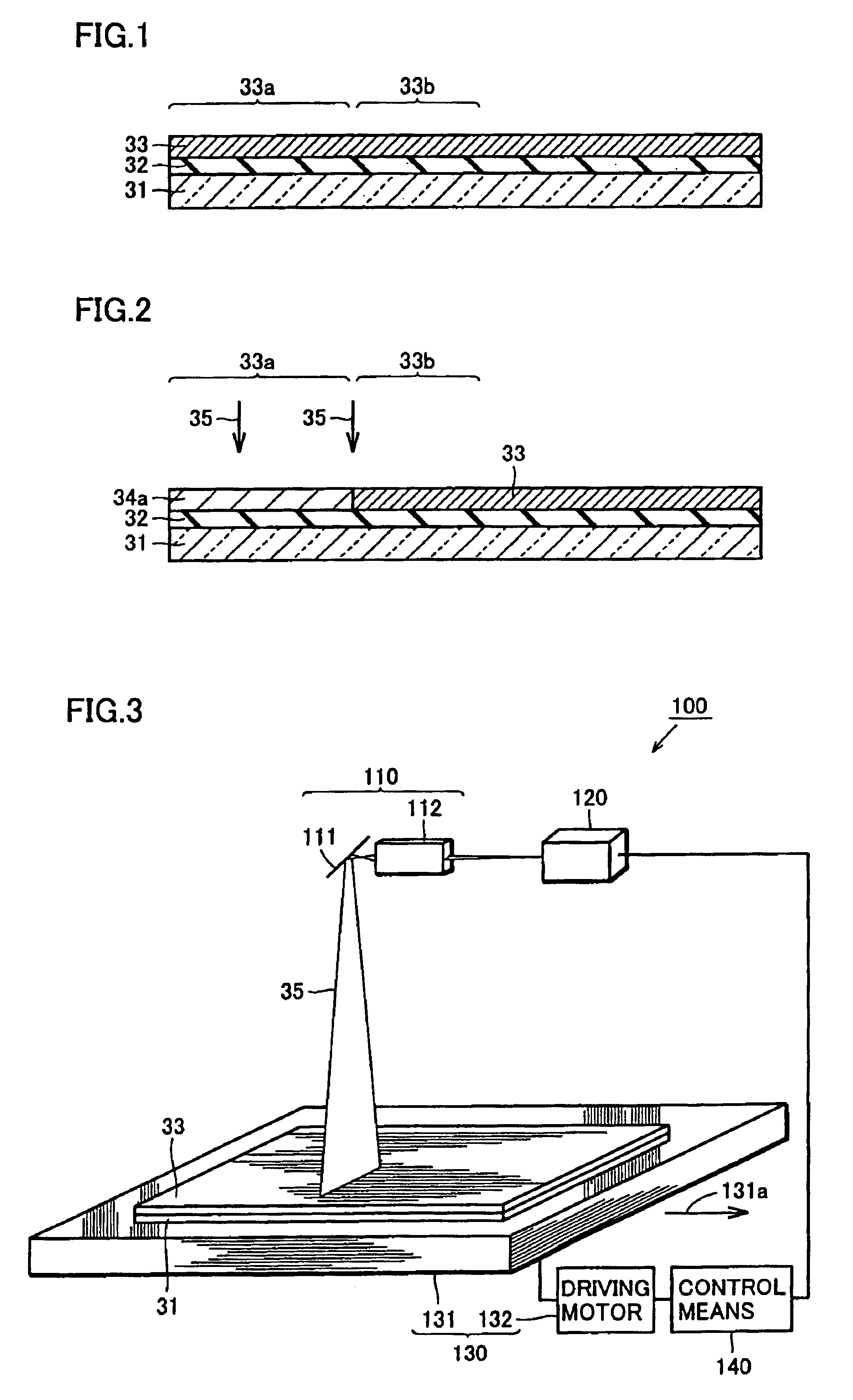Process and unit for production of polycrystalline silicon film
a polycrystalline silicon and film technology, applied in the direction of manufacturing tools, instruments, non-linear optics, etc., can solve the problems of low performance of thin film transistors, low efficiency, and difficulty in fabricating integrated circuits where high speed and high performance are required, and achieve low cost, high productivity, and efficient production
- Summary
- Abstract
- Description
- Claims
- Application Information
AI Technical Summary
Benefits of technology
Problems solved by technology
Method used
Image
Examples
first embodiment
[0057]FIGS. 1 to 6 are views showing a process for a polycrystal silicon film according to a first embodiment of this invention. Referring to FIG. 1, a silicon oxide film 32 is formed on a glass substrate 31 by means of, for example, a CVD method. An amorphous silicon film 33 is formed on silicon oxide film 32 by means of a CVD method. This amorphous silicon film 33 has a first region 33a and a second region 33b that contacts this first region 33a.
[0058]Referring to FIGS. 2 and 3, first region 33a of amorphous silicon film 33 is irradiated with the second harmonics laser (wavelength 532 nm) of Nd: YAG of the Q switch. Thereby, a portion irradiated with a laser 35 is polycrystallized so as to form a first polycrystal portion 34a. At this time, a unit, as shown in FIG. 3, is used for the irradiation by the laser.
[0059]Referring to FIG. 3, a polycrystal silicon film production unit 100 is provided with a laser oscillator 120 as an oscillation means for oscillating a laser of which the...
second embodiment
[0084]FIG. 13 is a perspective view showing a process for a polycrystal silicon film according to a second embodiment of this invention. The irradiation means of a polycrystal silicon film production unit 180, shown in FIG. 13, differs from that of the polycrystal silicon film production unit 100. That is to say, in the polycrystal silicon film production unit 180, shown in FIG. 13, a first irradiation means 110a, a second irradiation means 110b and a third irradiation means 110c exist as the irradiation means. First, second and third irradiation means 110a, 110b and 110c are, respectively, formed of a mirror 111 and a beam formation optical system 112. Mirror 111 and beam formation optical system 112 are similar to those shown in FIG. 3. A laser oscillator 120a, as the first oscillation means, a laser oscillator 120b as the second oscillation means and a laser oscillator 120c as the third oscillation means are connected to respective beam formation optical systems 112. Laser oscill...
third embodiment
[0091]FIG. 17 is a perspective view of a production unit for a polycrystal silicon film according to a third embodiment of this invention. Referring to FIG. 17, a polycrystal silicon film production unit 190 according to the third embodiment differs from that of other embodiments in the point that a laser oscillated from one laser oscillator 420 is used by three irradiation means. That is to say, the irradiation means has a first irradiation means 210a, a second irradiation means 210b and a third irradiation means 210c. Irradiation means 210a, 210b and 210c have, respectively, a beam formation optical system 112 and a mirror 111 that are the same as those in the first embodiment. The mirror 114 reflects a laser that is oscillated by laser oscillator 420 of which the wavelength is not less than 390 nm and not more than 640 nm so that amorphous silicon film 33 is irradiated with this laser in the form of lasers 35a, 35b and 35c via beam formation optical systems 112 and mirrors 111. T...
PUM
| Property | Measurement | Unit |
|---|---|---|
| wavelength | aaaaa | aaaaa |
| wavelength | aaaaa | aaaaa |
| wavelength | aaaaa | aaaaa |
Abstract
Description
Claims
Application Information
 Login to View More
Login to View More - R&D
- Intellectual Property
- Life Sciences
- Materials
- Tech Scout
- Unparalleled Data Quality
- Higher Quality Content
- 60% Fewer Hallucinations
Browse by: Latest US Patents, China's latest patents, Technical Efficacy Thesaurus, Application Domain, Technology Topic, Popular Technical Reports.
© 2025 PatSnap. All rights reserved.Legal|Privacy policy|Modern Slavery Act Transparency Statement|Sitemap|About US| Contact US: help@patsnap.com



